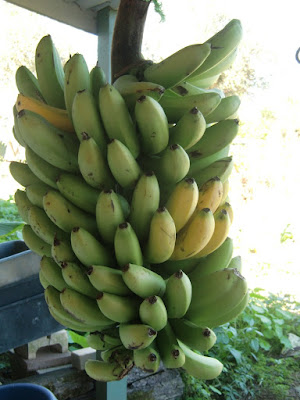We harvested one rather mediocre bunch mid-winter. The flavour was not much to brag about. I usually don't care much for Cavendish bananas. They are too bland, lacking that citrusy zing of the Lady Fingers, or the creamy texture of the Golden Cream variety.
A month or so ago, we saw bunches begin to suddenly appear. First one, then a second. Looking from below, even tho these are short trees, we could not see more. Then, overnight, another bunch, then another. Finally we had six bunches, all hanging at the same time.
Too heavy for the small trees, we had to prop some up. The first two broke the stems of the tress and had to be harvested right then. So we hung them on the back veranda and watched. Now they are getting yellow-ish. A few bananas, ahead of the others, got quite yellow and I carefully extracted them from the bunch, to try them. I was surprised to find them quite flavourful.
That was the moment when it hit me: we were about to have a glut. So many bananas, what would we do with them all? My calculations at first came to about 600. Now I am certain the total will be nearer to 750 bananas!
 |
| The first bunch to be harvested. |
 |
| The second bunch. Each has around 120 bananas on it. |
 |
| The Solar Dehydrator and Bee's Wax Melter |
 |
| The bottom space is for melting and purifying bees wax. A framework to support the aluminium pans will be added. |
 |
| The interior of the top box. Shelf supports on the sides and ports in the bottom to admit heated air from below. |
The first trial of the dehydrator was with Rosella flowers. I dried, very successfully, almost 200 grams of hibiscus flowers. That's dry weight, so its a lot of red dried flowers for tea.
 |
| Rosella, dried flowers |
 | |||
| A rack full of chips, about 13 bananas worth. |
 | |||||
| Six racks full of Banana Chips. Hope they are not too thick! |